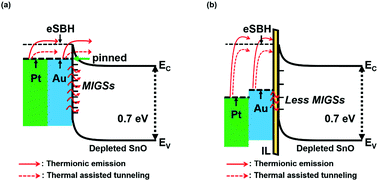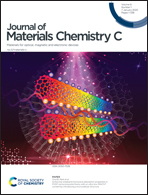Improved switching characteristics of p-type tin monoxide field-effect transistors through Schottky energy barrier engineering†
Abstract
A low on–off current modulation ratio (ION/OFF) in p-type tin monoxide (SnO) field-effect transistors (FETs) is a critical bottleneck hampering their widespread application to transparent complementary metal oxide semiconductors (CMOSs) or monolithic integrated devices. To solve this problem, this study focuses on the source/drain (S/D) contact region. Also, a new perspective on the origin of the high off-current in SnO FETs, an electron injection from the drain electrode into the channel by Fermi-level pinning (FLP) at the off-state, is suggested. In this work, a metal–interlayer–semiconductor (MIS) S/D contact structure is adopted to suppress this adverse electron injection. An ultrathin interlayer (IL) of MIS contact alleviates metal-induced gap state (MIGS) penetration which is a primary cause of the severe FLP. A considerable enhancement is achieved by using the MIS contact structure: the off-current value decreased by approximately 20-fold from 5.1 × 10−8 A to 2.4 × 10−9 A; the ION/OFF value increased 10-fold from 2.7 × 102 to 2.8 × 103, which is interpreted by increased MIS contact-mediated electron SBH. This work presents a new approach that can be easily used alongside previously reported methods to suppress the off-current, providing enhanced switching capability of p-type SnO FETs using a simple method.



 Please wait while we load your content...
Please wait while we load your content...